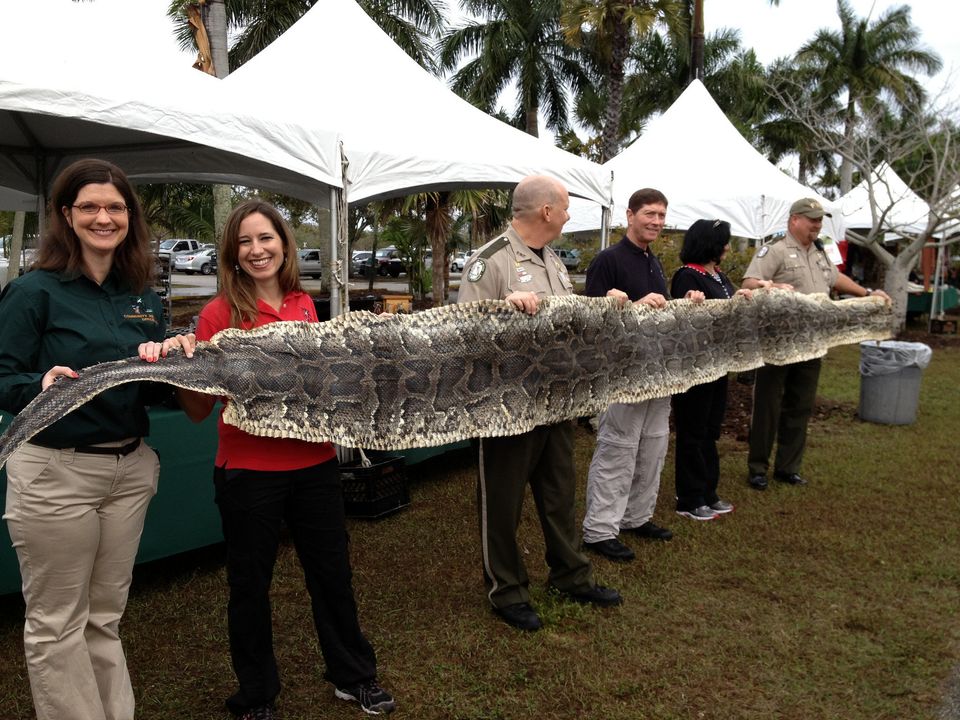
TAMPA -- The state of Florida this weekend unleashed a thrill-seeking public on the Burmese python, an invasive species that has set up house in the Florida Everglades and surrounding wildlife management areas over the past decade or so.
Nearly 800 people pre-registered for the inaugural Python Challenge, which began at 1 p.m. Saturday and lasts until midnight Feb. 10. Another couple hundred signed up on Saturday, said Carli Segelson, spokeswoman with the Florida Fish and Wildlife Conservation Commission.
By the end of the day, Segelson said, probably more than 1,000 snake hunters, some experienced and many not, had paid the $25 entry fee and signed up to go out sometime over the next month.
Based on results from the first weekend, a lot more people might need to sign up to appreciably diminish a python population estimated in the tens of thousands.
By 4 p.m. today, hunters had turned in a total of 11 dead snakes to the wildlife commission.
"I didn't see any snakes, much less Burmese pythons," Mark Reynolds of Seffner said this morning. "I saw plenty of alligators and birds and fish, but not a single snake of any kind."
Reynolds headed to the Big Cypress National Preserve on Saturday afternoon, set up camp and lit out in search of the big snake. He said he cruised up and down dirt roads in Big Cypress, looking along banks of canals, thinking snakes would be out basking in the sun.
They weren't.
His quest may be done for the weekend, but it's not over, he said, and he plans to make another trip or two to the region in hopes of the elusive python. Such a trip could be fruitful: the contest offers $1,500 for the most snakes, $1,000 for the largest.
"My plans are to go back again," he said. "I'm not expecting to see anything, but if I do, it'll be a bonus."
The snakes can grow to enormous lengths, sometimes more than 20 feet long. The idea behind the roundup is to put a dent in the population that is stealing food from the natural fauna, at best, and killing them, at worst.
While Burmese pythons can be large, they are well camouflaged in the swamps and hammocks of the wildlife management areas that ring the Everglades.
Hunters who have registered for the contest hail from 30 states, from as far away as California and Michigan. Besides removing unwanted reptiles from Florida's wilderness, the Python Challenge is designed to raise public awareness of the problem and give biologists data they need to more fully understand how, where and why pythons are thriving.
"The 2013 Python Challenge is an unprecedented effort to focus public interest, support and direct involvement to help deal with Burmese pythons," said commission Chairman Kenneth Wright at a Saturday news conference in Davie. "Floridians and people from all across the United States truly care about the Florida Everglades, and they are clearly eager to help us better understand and solve this problem."
About a dozen snake wranglers showed up Saturday morning in South Florida to get last-minute training on things like gun safety, keeping hydrated and avoiding sunburn. Many hunters bypassed the ceremonial kick-off of the event, opting to head straight into the woods.
The "harvesting" of snakes means killing them, and there are by-the-book ways to do that -- mostly a bullet into the top of the head.
Decapitating the squirming beast is not really recommended, because, biologists say, the brain of a python remains active for hours even after it is separated from the rest of the body and experiences excruciating pain during that time.
When dropping off a harvested Burmese python to be counted, hunters are being asked for details such as GPS location, what habitat the snake was in and other details.
The python arrived in the Sunshine State as an exotic pet. But if regularly fed, they tend to grow and grow. Some owners couldn't handle hungry snakes as long as their sectional couch. So they let them loose into the wilds of the Everglades, where the snakes found each other and established growing populations.
The burgeoning python population in the Everglades prompted a state law in recent years against buying and selling Burmese pythons for use as pets and a federal law banning the import or interstate sale of pythons. ___
(c)2013 the Tampa Tribune (Tampa, Fla.)
Visit the Tampa Tribune (Tampa, Fla.) at www.tampatrib.com
Distributed by MCT Information Services
